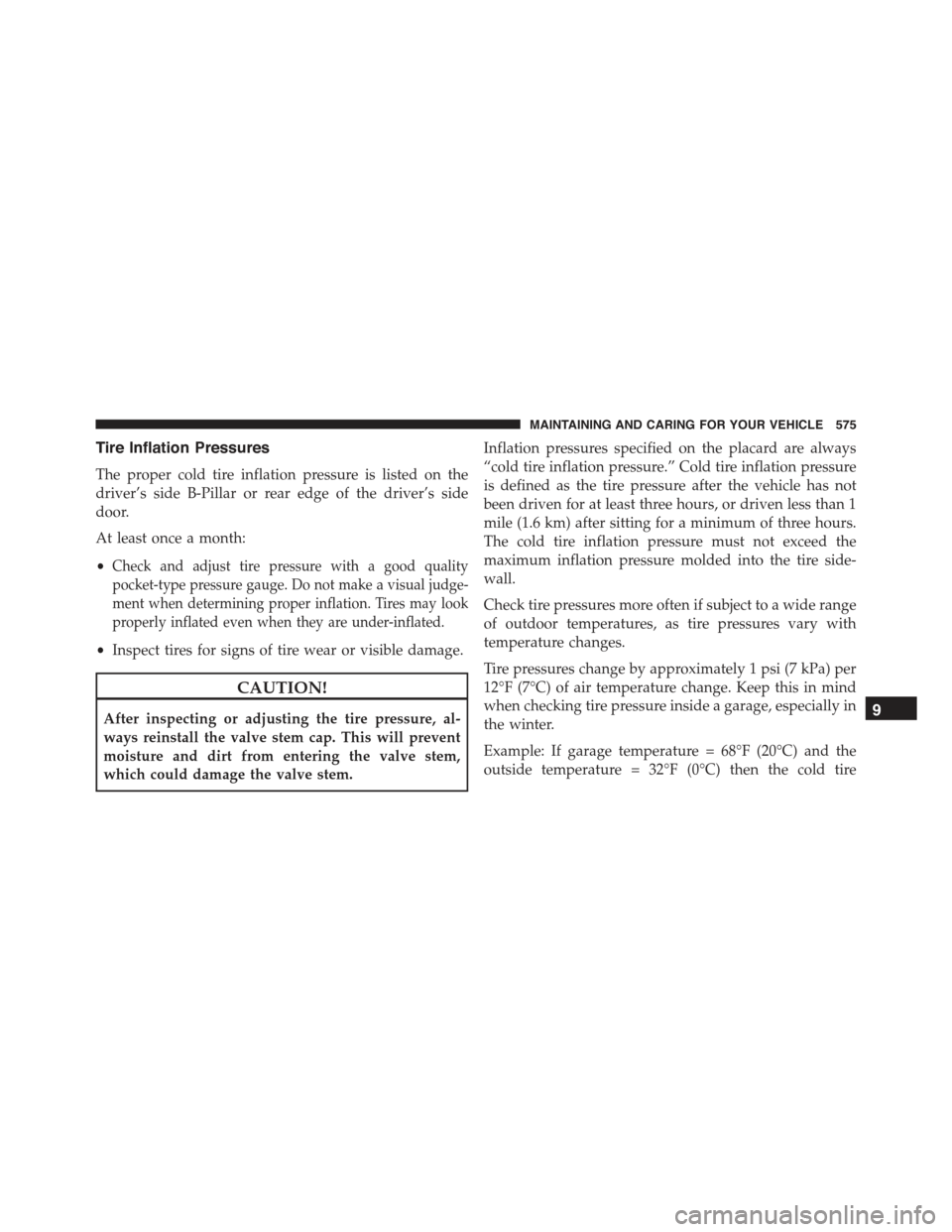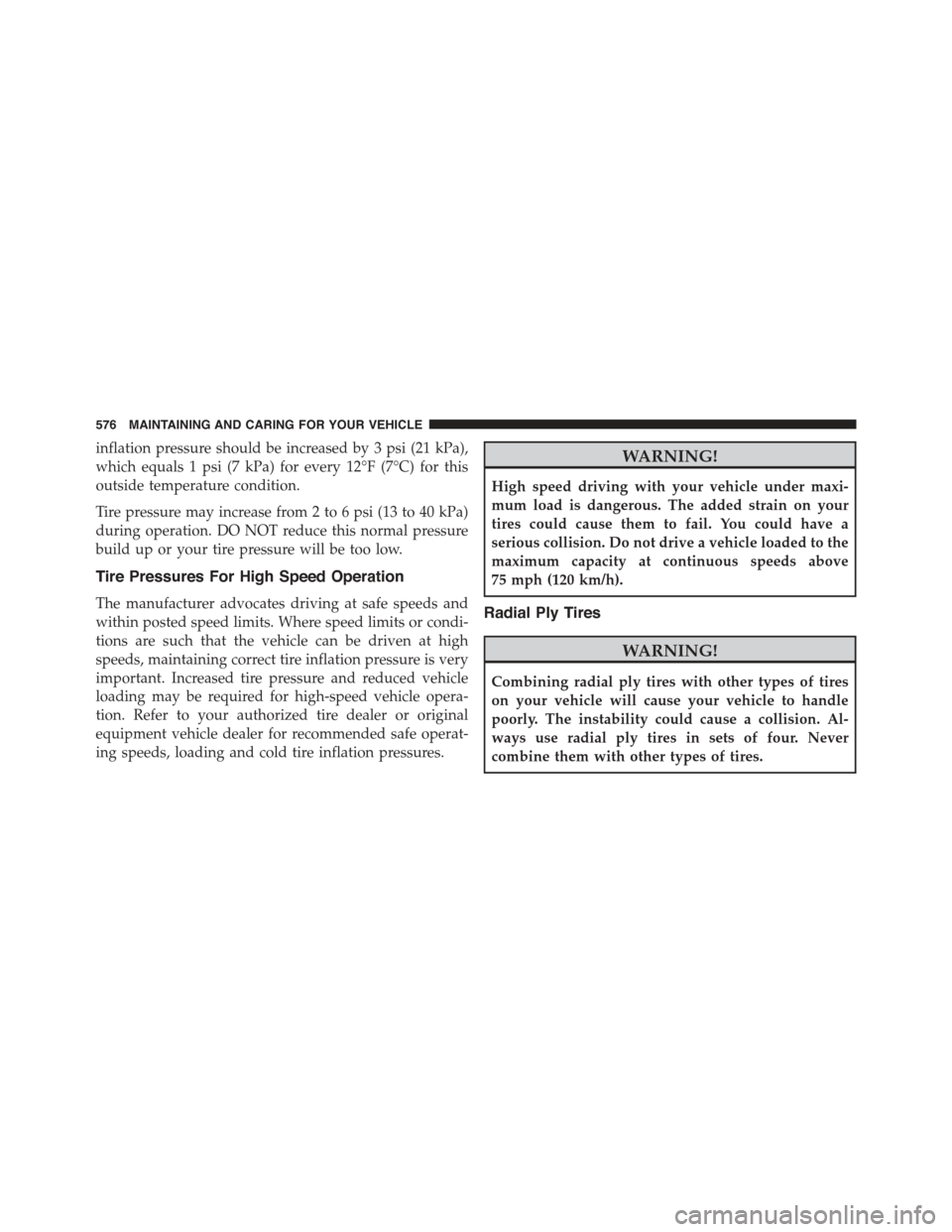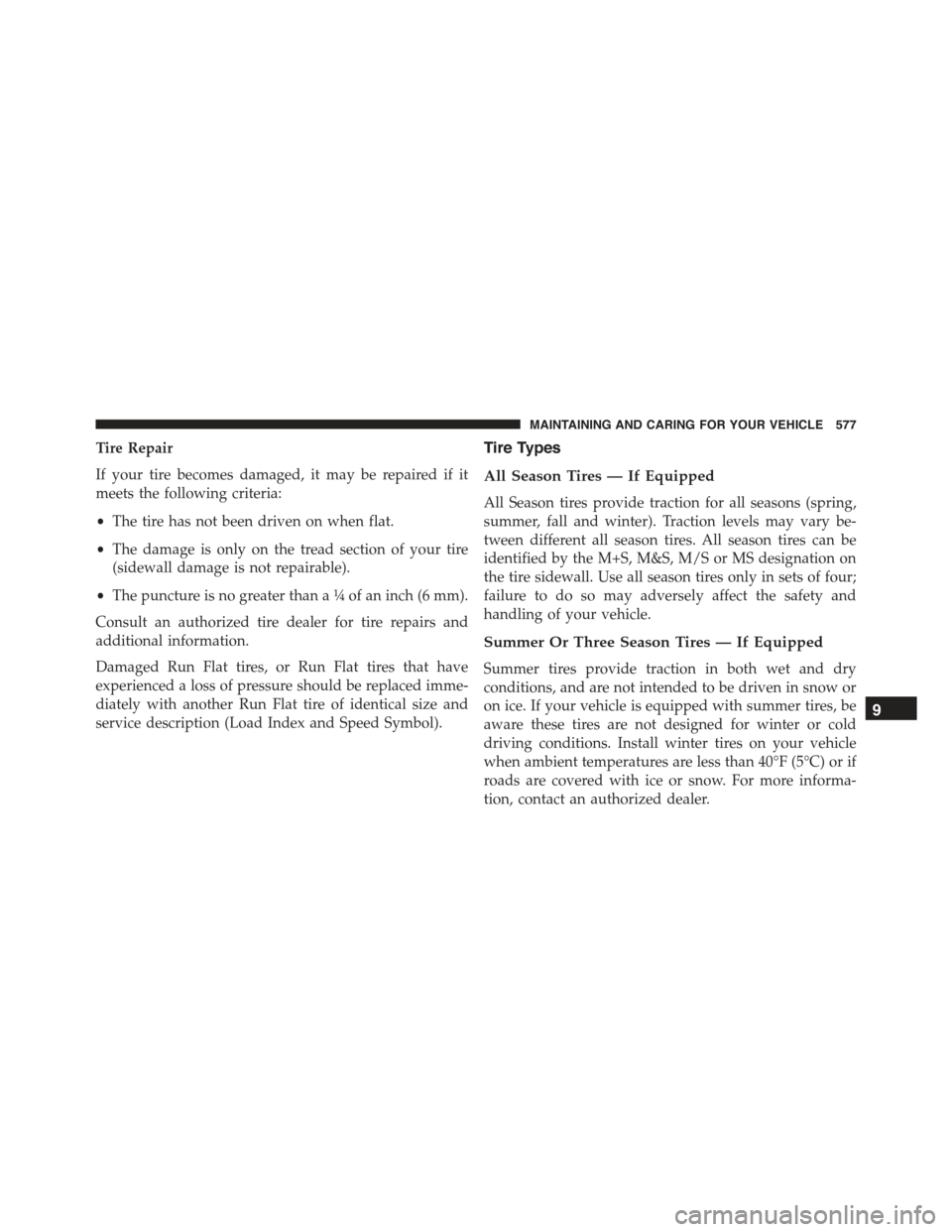2015 JEEP RENEGADE tire type
[x] Cancel search: tire typePage 577 of 678

Tire Inflation Pressures
The proper cold tire inflation pressure is listed on the
driver’s side B-Pillar or rear edge of the driver’s side
door.
At least once a month:
•Check and adjust tire pressure with a good quality
pocket-type pressure gauge. Do not make a visual judge-
ment when determining proper inflation. Tires may look
properly inflated even when they are under-inflated.
•Inspect tires for signs of tire wear or visible damage.
CAUTION!
After inspecting or adjusting the tire pressure, al-
ways reinstall the valve stem cap. This will prevent
moisture and dirt from entering the valve stem,
which could damage the valve stem.
Inflation pressures specified on the placard are always
“cold tire inflation pressure.” Cold tire inflation pressure
is defined as the tire pressure after the vehicle has not
been driven for at least three hours, or driven less than 1
mile (1.6 km) after sitting for a minimum of three hours.
The cold tire inflation pressure must not exceed the
maximum inflation pressure molded into the tire side-
wall.
Check tire pressures more often if subject to a wide range
of outdoor temperatures, as tire pressures vary with
temperature changes.
Tire pressures change by approximately 1 psi (7 kPa) per
12°F (7°C) of air temperature change. Keep this in mind
when checking tire pressure inside a garage, especially in
the winter.
Example: If garage temperature = 68°F (20°C) and the
outside temperature = 32°F (0°C) then the cold tire
9
MAINTAINING AND CARING FOR YOUR VEHICLE 575
Page 578 of 678

inflation pressure should be increased by 3 psi (21 kPa),
which equals 1 psi (7 kPa) for every 12°F (7°C) for this
outside temperature condition.
Tire pressure may increase from 2 to 6 psi (13 to 40 kPa)
during operation. DO NOT reduce this normal pressure
build up or your tire pressure will be too low.
Tire Pressures For High Speed Operation
The manufacturer advocates driving at safe speeds and
within posted speed limits. Where speed limits or condi-
tions are such that the vehicle can be driven at high
speeds, maintaining correct tire inflation pressure is very
important. Increased tire pressure and reduced vehicle
loading may be required for high-speed vehicle opera-
tion. Refer to your authorized tire dealer or original
equipment vehicle dealer for recommended safe operat-
ing speeds, loading and cold tire inflation pressures.
WARNING!
High speed driving with your vehicle under maxi-
mum load is dangerous. The added strain on your
tires could cause them to fail. You could have a
serious collision. Do not drive a vehicle loaded to the
maximum capacity at continuous speeds above
75 mph (120 km/h).
Radial Ply Tires
WARNING!
Combining radial ply tires with other types of tires
on your vehicle will cause your vehicle to handle
poorly. The instability could cause a collision. Al-
ways use radial ply tires in sets of four. Never
combine them with other types of tires.
576 MAINTAINING AND CARING FOR YOUR VEHICLE
Page 579 of 678

Tire Repair
If your tire becomes damaged, it may be repaired if it
meets the following criteria:
•The tire has not been driven on when flat.
•The damage is only on the tread section of your tire
(sidewall damage is not repairable).
•The puncture is no greater thana¼ofaninch (6 mm).
Consult an authorized tire dealer for tire repairs and
additional information.
Damaged Run Flat tires, or Run Flat tires that have
experienced a loss of pressure should be replaced imme-
diately with another Run Flat tire of identical size and
service description (Load Index and Speed Symbol).
Tire Types
All Season Tires — If Equipped
All Season tires provide traction for all seasons (spring,
summer, fall and winter). Traction levels may vary be-
tween different all season tires. All season tires can be
identified by the M+S, M&S, M/S or MS designation on
the tire sidewall. Use all season tires only in sets of four;
failure to do so may adversely affect the safety and
handling of your vehicle.
Summer Or Three Season Tires — If Equipped
Summer tires provide traction in both wet and dry
conditions, and are not intended to be driven in snow or
on ice. If your vehicle is equipped with summer tires, be
aware these tires are not designed for winter or cold
driving conditions. Install winter tires on your vehicle
when ambient temperatures are less than 40°F (5°C) or if
roads are covered with ice or snow. For more informa-
tion, contact an authorized dealer.
9
MAINTAINING AND CARING FOR YOUR VEHICLE 577
Page 580 of 678

Summer tires do not contain the all season designation or
mountain/snowflake symbol on the tire sidewall. Use
summer tires only in sets of four; failure to do so may
adversely affect the safety and handling of your vehicle.
WARNING!
Do not use summer tires in snow/ice conditions. You
could lose vehicle control, resulting in severe injury
or death. Driving too fast for conditions also creates
the possibility of loss of vehicle control.
Snow Tires
Some areas of the country require the use of snow tires
during the winter. Snow tires can be identified by a
“mountain/snowflake” symbol on the tire sidewall.
If you need snow tires, select tires
equivalent in size and type to the origi-
nal equipment tires. Use snow tires
only in sets of four; failure to do so
may adversely affect the safety and
handling of your vehicle.
Snow tires generally have lower speed ratings than what
was originally equipped with your vehicle and should
not be operated at sustained speeds over 75 mph
(120 km/h). For speeds above 75 mph (120 km/h) refer to
original equipment or an authorized tire dealer for
recommended safe operating speeds, loading and cold
tire inflation pressures.
While studded tires improve performance on ice, skid
and traction capability on wet or dry surfaces may be
poorer than that of non-studded tires. Some states pro-
hibit studded tires; therefore, local laws should be
checked before using these tire types.
578 MAINTAINING AND CARING FOR YOUR VEHICLE
Page 586 of 678

Four Wheel Drive (4WD) Non-Trailhawk Models with-
out a Two-Speed Power Takeoff Unit
•Original equipment 215/60R17 and 225/55R18 tire
sizes are not chainable.
•The use of 9mm snow chains is permitted with the use
of 215/60R16 tires.
Four Wheel Drive (4WD) Non-Trailhawk Models with a
Two-Speed Power Takeoff Unit
•The use of 7mm snow chains is permitted with the use
of 215/60R17 and 225/55R18 tires.
Four Wheel Drive (4WD) Trailhawk Models
•The use of 9mm snow chains is permitted with the use
of 215/60R17 tires.
CAUTION!
•Use on Front Tires Only
•Damage to Front Wheel Drive (FWD) Models may
result if tire chains or traction devices are used with
original equipment size tires.
•Damage to Four Wheel Drive (4WD) Models with-
out a Two-Speed Power Takeoff Unit may result if
tire chains or traction devices are used with origi-
nal equipment size tires.
•Damage to Four Wheel Drive (4WD) Trailhawk
Models may result if tire chains or traction devices
are used with original equipment size tires.
WARNING!
Using tires of different size and type (M+S, Snow)
between front and rear axles can cause unpredictable
handling. You could lose control and have a collision.
584 MAINTAINING AND CARING FOR YOUR VEHICLE
Page 588 of 678

type tires. Rotation will increase tread life, help to main-
tain mud, snow, and wet traction levels, and contribute to
a smooth, quiet ride.
Refer to the “Maintenance Schedule” for the proper
maintenance intervals. The reasons for any rapid or
unusual wear should be corrected prior to rotation being
performed.
The suggested Front Wheel Drive (FWD) rotation
method is the “rearward cross” shown in the following
diagram. This rotation pattern does not apply to some
directional tires that must not be reversed.
The suggested Four Wheel Drive (4WD) Tire rotation
method is the “forward-cross” shown in the following
diagram.
Front Wheel Drive (FWD) Tire Rotation
586 MAINTAINING AND CARING FOR YOUR VEHICLE
Page 589 of 678

CAUTION!
Proper operation of four-wheel drive vehicles de-
pends on tires of equal size, type and circumference
on each wheel. Any difference in tire size can cause
(Continued)
CAUTION!(Continued)
damage to the power transfer unit. Tire rotation
schedule should be followed to balance tire wear.
VEHICLE STORAGE
If the vehicle should remain stationary for more than a
month, observe the following precautions:
•Park your vehicle in a covered, dry and possibly airy
location the windows open slightly;
•Check that the Electric Park Brake is not engaged.
•Disconnect the negative (-) terminal from the battery
post and be sure that the battery is fully charged.
During storage check battery charge quarterly.
•If you do not disconnect the battery from the electrical
system, check the battery charge every thirty days.
Four Wheel Drive (4WD) Tire Rotation
9
MAINTAINING AND CARING FOR YOUR VEHICLE 587
Page 671 of 678

Radio Operation..........................637
Rear Camera............................375
Rear Cross Path...........................91
Rear ParkSense System.....................369
Rearview Mirrors..........................81
Rear Window Defroster.....................107
Rear Wiper/Washer........................107
Recorder, Event Data.......................285
Recreational Towing.......................422
Reformulated Gasoline.....................389
Refrigerant..............................535
Reminder, Lights On........................98
Reminder, Seat Belt........................254
Remote Control
Starting System.........................45
Remote Keyless Entry (RKE)..................31
Arm The Alarm.........................51
FCC General Information..................34
Keyless Enter-N-Go™™...................56
Programming Additional Key Fobs...........40
Programming Additional Transmitters.........40
Remote Sound System (Radio) Controls.........636
Remote Starting
Exit Remote Start Mode...................48
Uconnect® Customer Programmable Features....48
Uconnect® Settings.......................48
Remote Starting System......................45
Replacement Keys.........................40
Replacement Parts.........................515
Replacement Tires.........................581
Reporting Safety Defects.....................14
Restraint, Head...........................77
Restraints, Child..........................287
Restraints, Occupant.......................252
Roll Over Warning..........................7
Roof Type Carrier.........................172
Rotation, Tires...........................585
12
INDEX 669